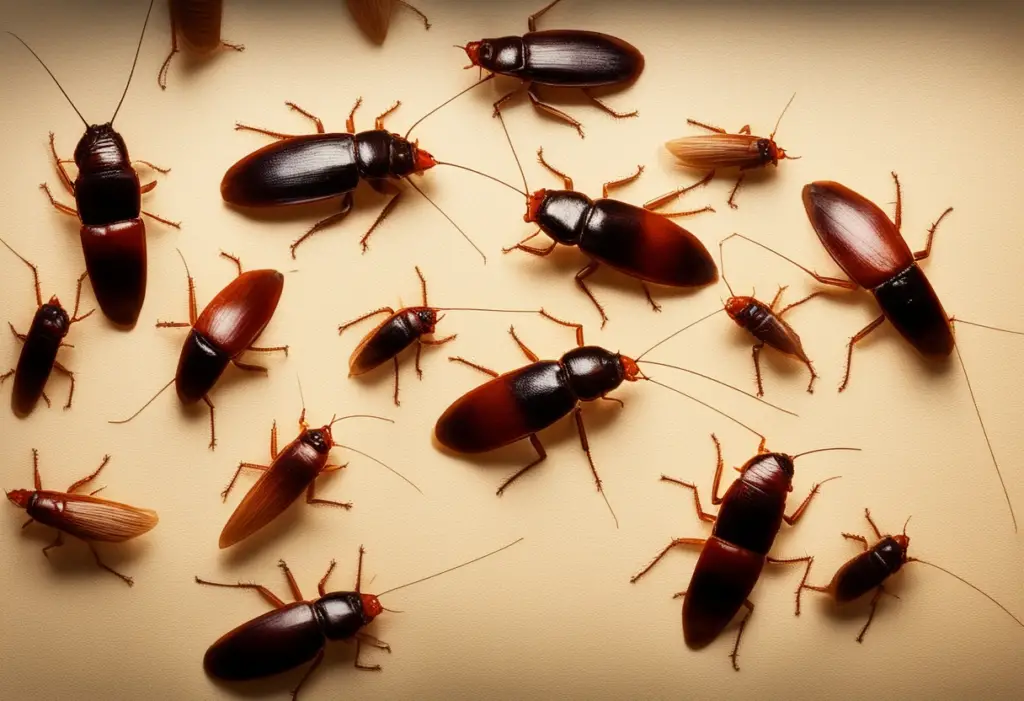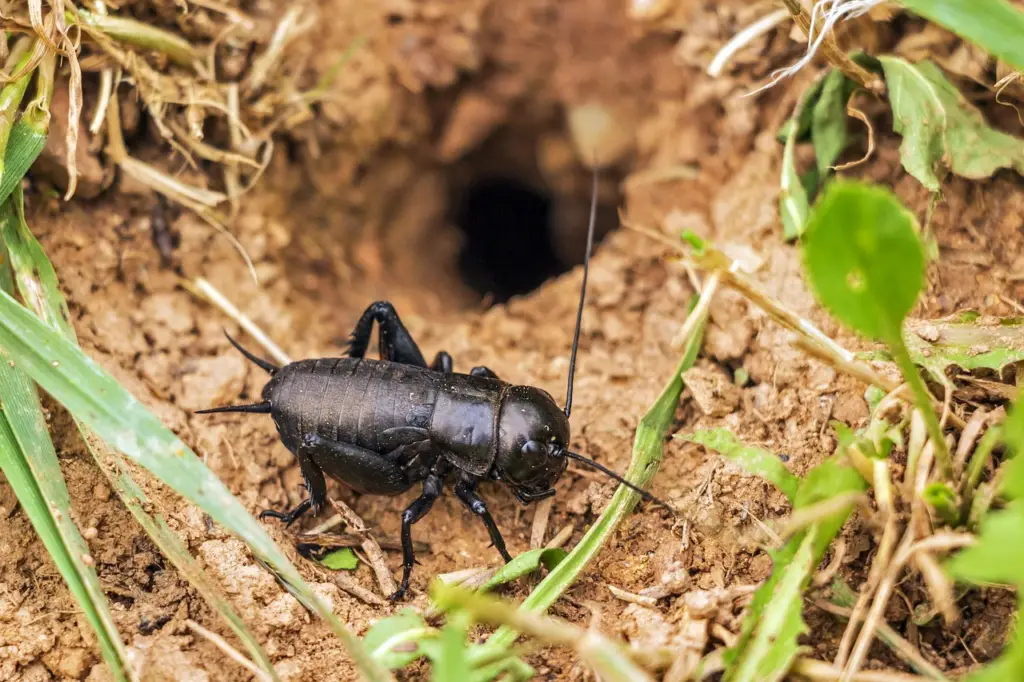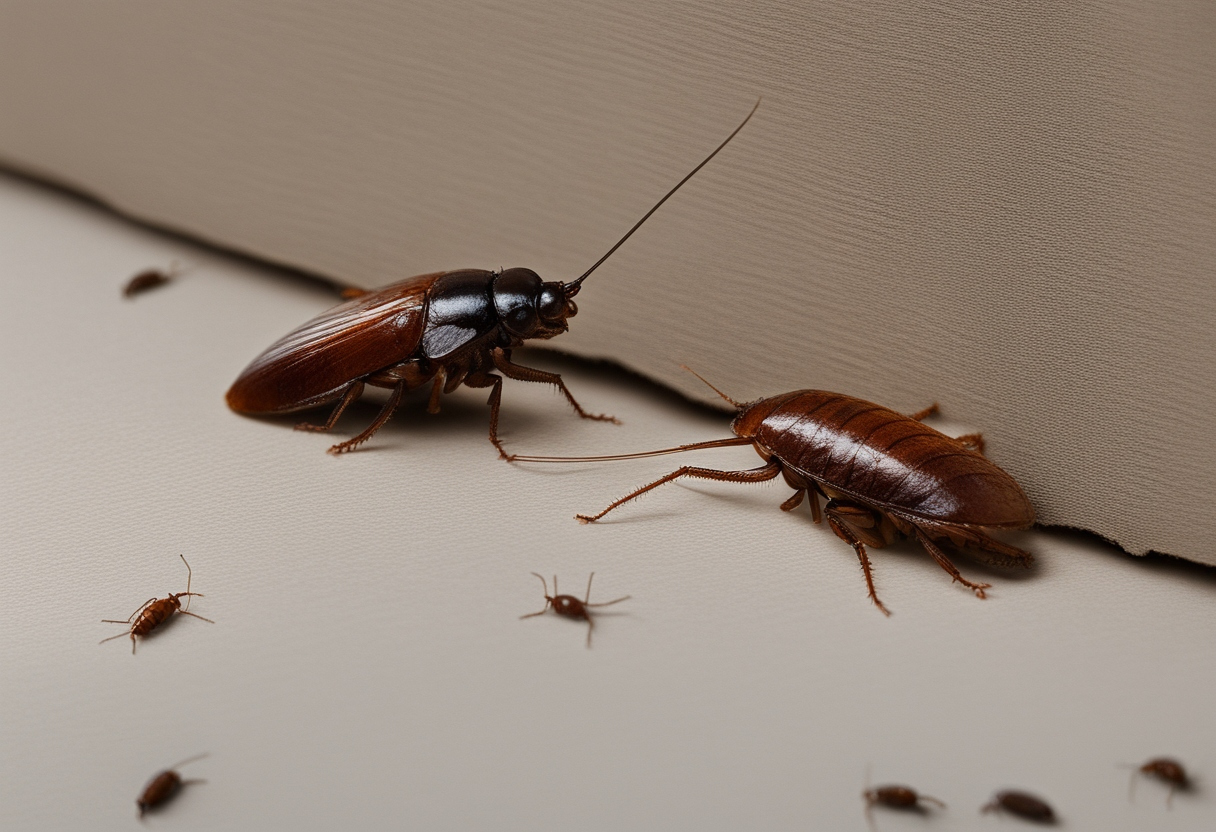Ever wondered if those creepy crawling cockroaches eat crickets? The answer is yes, cockroaches are opportunistic eaters and will happily munch on a cricket if the opportunity arises. Their omnivorous diet means they’ll consume both plant and animal matter, including other insects. But don’t expect them to specifically hunt crickets – they’re more scavengers, feasting on whatever organic material they find.
Do Cockroaches Eat Crickets?
Imagine this: you wake up in the middle of the night and head to the kitchen for a snack. You open the pantry and discover a cricket has somehow snuck in and is munching on your cereal. Grossed out? That’s probably how a cricket feels encountering a cockroach in its usual habitat.
Cockroaches aren’t exactly stealthy predators, and crickets, with their excellent hearing (thanks to those tympana on their legs), would likely detect them approaching and attempt to escape. However, if a cricket is injured, molting (shedding its exoskeleton), or simply unlucky enough to be caught unaware by a hungry cockroach, it could become an unexpected meal.
Are Cockroaches Picky Eaters?
Absolutely not! Cockroaches are the epitome of culinary flexibility. As omnivores, they thrive on a diverse diet that would make even the most adventurous human eater raise an eyebrow. Here’s a look at some of their favorite (or perhaps least disliked) foods:
- Starchy delights: Bread, cereals, crackers, cookies – anything with a high starch content is a cockroach’s dream come true. These starchy carbs provide them with energy to fuel their nocturnal escapades.
- Sugary treats: Candy, fruits, sugary drinks – while not the healthiest option for any living being, cockroaches have a sweet tooth and will gladly indulge in sugary treats if they find them.
- Fatty feasts: Grease, oils, meats – cockroaches won’t turn down a greasy burger or a forgotten slice of pizza. These fatty foods provide them with essential oils and fats for survival.
- Protein power-ups: Other insects, including deceased cockroaches (yes, you read that right!), become a protein source for these resourceful scavengers.
- Leftovers: Decaying organic matter and even human waste are, unfortunately, fair game for cockroaches. This is why it’s crucial to maintain cleanliness and eliminate potential food sources to deter them from entering your home.
This adaptability allows them to survive in various environments, from sewers and damp basements to kitchens and bathrooms. It’s no wonder they’ve earned the reputation of being nearly indestructible pests.

What Insects Do Cockroaches Eat?
While crickets aren’t their prime target, cockroaches won’t hesitate to add them to the menu if the opportunity arises. Here’s a closer look at some other insects they might encounter and potentially consume:
- Beetles: Smaller beetle species are particularly vulnerable to a hungry cockroach. Unlike some beetles with tough exoskeletons, smaller varieties might not be able to put up much of a fight.
- Flies: Fruit flies and houseflies can become a quick snack for a cockroach. These small, sluggish insects are easy prey, especially for larger cockroach species.
- Ants: Smaller ant varieties, especially those that venture out in search of food sources, can fall prey to these opportunistic feeders. However, it’s important to note that some ant species, particularly those known for their stinging capabilities, could deter cockroaches.
- Termites: Though similar in appearance and both living in social colonies, cockroaches and termites don’t share the same diet. However, in some situations, cockroaches can overpower and eat termites, especially if they encounter weak or solitary termites.
- Springtails: These tiny, jumping insects might be seen as a light appetizer for a cockroach. Due to their small size and lack of any significant defense mechanisms, springtails are easy pickings for a hungry scavenger.
It’s important to note that this list isn’t exhaustive. The specific insects on a cockroach’s plate depend on the environment and available options. In a kitchen, they might encounter crumbs, spilled sugary drinks, and even other insects attracted to the same food sources. In a damp basement, they might find decaying organic matter, mold, and perhaps even millipedes or centipedes (which they might also consume).
The key takeaway is that cockroaches are not picky eaters. Their omnivorous diet and scavenging behavior make them a threat to other insects in their environment, including crickets.
Do Crickets Eat Cockroaches?
The tables can be turned! While primarily herbivores, crickets can exhibit omnivorous tendencies when food is scarce. In such situations, a smaller cockroach nymph (a young cockroach that hasn’t reached adulthood yet) or a molting adult (with its softer exoskeleton) could become a meal for a particularly hungry cricket.
Imagine a cockroach in its usual dark, damp hiding spot. Suddenly, a cricket leaps in, startled by a loud noise. The cockroach, surprised and sluggish, doesn’t react fast enough. The cricket, with its powerful jaws, might seize the opportunity for a protein-rich snack. However, this scenario is unlikely in most situations.
Crickets, despite their jumping prowess, aren’t exactly stealthy predators. They rely more on camouflage and hiding to avoid becoming prey themselves. Additionally, cockroaches, while not the most agile creatures, do have some defensive mechanisms. They can release a foul-smelling odor to deter attackers and have spiky legs that can inflict minor scratches.
Therefore, while crickets can technically eat cockroaches under the right circumstances, they aren’t natural predators and wouldn’t actively hunt them.

Do Cockroaches Benefit Humans in Any Way?
While the idea might be unsettling, cockroaches do play a minor role in the ecosystem. They help decompose organic matter, promoting nutrient cycling. This means they contribute to breaking down dead plants and animals into usable nutrients for other organisms.
Think of it this way: when leaves fall from trees and other organic material dies, it needs to decompose to return nutrients to the soil. Cockroaches, along with other decomposers like worms and fungi, play a crucial role in this process. By feeding on decaying matter, they break it down into smaller particles that can be absorbed by plants, thus continuing the cycle of life.
Additionally, some cockroach species are being studied for their potential use in medicine. Research is exploring their immune system and disease resistance. Cockroaches have been around for millions of years and have developed remarkable resilience to various pathogens. By studying their immune system, scientists might gain insights that could help develop new treatments for human diseases.
For instance, some research suggests that certain cockroach species might carry antimicrobial peptides (AMPs) – molecules that fight bacteria and other microbes. Understanding how these AMPs function could pave the way for the development of new antibiotics.
However, it’s important to remember that the downsides of cockroaches far outweigh any potential benefits. They can contaminate food and surfaces with bacteria, trigger allergies, and are simply unpleasant houseguests.

How to Deal With a Cockroach or Cricket Infestation
If you suspect a cockroach or cricket infestation in your home, don’t wait! Taking swift action is crucial to prevent the problem from worsening. Here are some initial steps you can take:
- Identify the source: First, try to locate the entry point where these insects might be coming in. Common entry points include cracks around pipes, gaps under doors, or near windows.
- Seal entry points: Once you’ve identified potential entry points, seal them up using caulk or weather stripping. This will help prevent new insects from entering your home.
- Eliminate attractants: Cockroaches and crickets are attracted to food sources and moisture. Thoroughly clean your kitchen and bathroom, paying attention to areas where food crumbs or spills might linger. Address any leaky pipes or areas with high humidity.
- Use pest control products: Depending on the circumstances of your infestation, it may be possible to take a DIY approach by using various pest control products including baits, traps, or sprays.
Baits
Cockroach and cricket baits are readily available at hardware stores and online retailers. These baits typically contain a slow-acting insecticide combined with an attractant that entices the insects to feed. The cockroach or cricket consumes the bait, returns to its nest, and eventually dies. This domino effect can help eliminate the entire colony over time.
When choosing a bait, consider the type of insect you’re targeting (cockroaches or crickets) and the severity of the infestation. Different baits have varying levels of potency and attractants. Always follow the manufacturer’s instructions carefully for safe and effective use.
Here are some additional points to consider when using baits:
- Placement: Place baits in strategic locations where you’ve seen cockroach or cricket activity, such as near cracks and crevices, under cabinets, and behind appliances.
- Safety: Keep baits out of reach of children and pets. Many baits come in child-resistant containers, but it’s always best to exercise caution.
- Patience: Baits take time to work. Don’t expect instant results. It might take a few weeks to see a significant reduction in the insect population.
- Item Package Dimension: 8.4599999913708L x 5.8699999940126W x 1.649999998317H inches
- Item Package Weight – 0.220462262 Pounds
- Item Package Quantity – 1
- Product Type – PEST CONTROL DEVICE
Traps
Sticky traps are another option for capturing cockroaches and crickets. These traps use a glue that ensnares the insect when it walks over the sticky surface. They are a non-toxic option and can be helpful for monitoring the extent of an infestation.
Here’s how to use sticky traps effectively:
- Placement: Place traps in areas with suspected activity, similar to bait placement. Focus on dark, damp areas where these insects might frequent.
- Monitoring: Regularly check your traps and replace them when they become full of insects or debris. This will help maintain their effectiveness.
- Limitations: Sticky traps primarily capture the insects that come into direct contact with the glue. They might not eliminate the entire infestation, especially if dealing with a large population. You may also consider pheromone traps that release attractant chemicals to draw the cockroaches to your trap for faster results.
Consider using traps in conjunction with other methods, such as baits or sprays, for a more comprehensive approach.
- EFFECTIVE CONTROL: Traps roaches, waterbugs; Palmetto bugs; spiders; crickets and scorpions
- HIDES DEAD BUGS: Conceals dead insects – just throw trap away when full
- PESTICIDE FREE: Contains no pesticides and no pesticide fumes or odors
- ATTRACTS ROACHES: Special lure attracts roaches into the trap; where they become stuck to the glue surface
- GUARANTEED: Guaranteed to work or your money back – see product label for details
Sprays
Insecticide sprays can be a powerful tool for killing cockroaches and crickets on contact. However, it’s important to weigh the benefits against the potential drawbacks before reaching for the spray can.
Here are some additional tips for using sprays effectively:
- Target specific areas: Focus on spraying cracks, crevices, and other areas where you’ve seen insect activity. Avoid spraying large areas unnecessarily.
- Treat hidden areas: If possible, use a pinpoint applicator or crack and crevice attachment to target hidden areas behind appliances or under cabinets.
- Follow-up treatment: Depending on the severity of the infestation, you might need to repeat the treatment after a certain period (as specified on the product label) to eliminate any newly hatched insects.
- KILLS ON CONTACT: Hot Shot Fogger With Odor Neutralizer kills on contact and controls heavy infestations – and keeps killing for up to 2 months.
- KILLS HIDDEN BUGS: Creates a fine, penetrating mist that reaches deep into cracks and crevices to kill the bugs you see and kill the bugs you don’t see.
- WHERE TO USE: Use in enclosed spaces such as apartments, attics, basements, barns, boat cabins, cabins, campers, crawl spaces, garages, homes, households, sheds, storage areas and trailers.
- NON-STAINING: This clear, non-staining formula won’t leave a wet, messy residue.
- EACH CAN COVERS 2,000 CU FT: Treats 2,000 cubic feet of unobstructed space
When Should You Contact a Pest Control Company?
If you’ve tried DIY methods like baits, traps, and sprays, and the cockroach or cricket infestation persists, it’s time to call in the professionals. Here are some signs that indicate professional help is necessary:
- Large infestation: If you’re seeing a significant number of cockroaches or crickets regularly, it suggests a well-established colony that requires professional intervention.
- Multiple locations: If you’ve spotted cockroaches or crickets in various areas of your home, it indicates a widespread infestation that might be difficult to eradicate on your own.
- Species identification: Certain cockroach species, like the German cockroach, are particularly difficult to eliminate. A pest control professional can identify the specific species and recommend the most effective treatment plan.
Don’t hesitate to contact a reputable pest control company if you’re overwhelmed by a cockroach or cricket infestation. They have the expertise, tools, and experience to safely and effectively eliminate the problem.
Final Thoughts
Cockroaches may not be picky eaters, but you can be! By keeping your home clean and eliminating potential food and water sources, you can deter these unwelcome guests. Additionally, sealing entry points and using preventative measures like baits or traps can go a long way in preventing infestations.
Remember, early detection and intervention are key. If you suspect a problem, address it quickly to avoid a larger issue. With a little vigilance and the right approach, you can keep your home free of creepy crawlies, be they crickets or cockroaches.
Frequently Asked Questions
Do cockroaches eat bed bugs?
Yes, cockroaches are opportunistic feeders and will consume bed bugs if they encounter them. However, bed bugs prefer blood meals and wouldn’t be a primary food source for cockroaches.
Do cockroaches eat ants?
Cockroaches can eat ants, especially smaller ant varieties. However, some ant species can fight back and deter cockroaches with their stings.
Do cockroaches eat each other?
Yes, cockroaches exhibit cannibalistic behavior. They may consume dead or molting cockroaches (shedding their exoskeleton) as a source of protein. This is why it is important to get rid of dead cockroaches, as they provide a food source and can attract new ones.
Do cockroaches eat spiders?
While not a common occurrence, cockroaches may scavenge on dead spiders or even attack weak or small spiders if the opportunity arises.
Do cockroaches eat worms?
Yes, cockroaches can eat worms, particularly smaller worm species. They are not picky eaters and will consume various organic matter, including worms.
Last update on 2024-07-27 / Affiliate links / Images from Amazon Product Advertising API. Please note that this page contains affiliate links, and we may make a commission from any purchases made through these links, at no additional cost to you.



